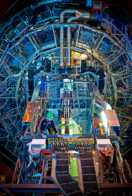
Normally, RS Ophiuchi is a faint astronomical object at a distance of about 5000 light years from Earth. Once every 15 years or so, however, it brightens dramatically to the point it becomes visible to the naked eye, only to disappear again within several days. This object, classified as a recurrent nova, is not a single star but rather a binary system consisting of a white dwarf and a red giant. Due to the proximity of the white dwarf to its massive companion, it slowly accumulates matter from which it forms a thin atmospheric-like layer on its surface. Over time, this atmosphere becomes denser and heats up until it reaches a critical temperature of around 20 million K. The thermonuclear explosion initiated at this temperature rapidly spreads across the dwarf’s surface, causing all the remaining material to be blown away. This process, which in the case of RS Ophiuchi occurs between every 9 to 26 years, makes the object visible in the optical region. However, the process has also been theorised to be capable of producing cosmic rays.
Bipolar shape
The first recorded explosion on RS Ophiuchi was in 1898 after it was discovered in optical images by Williamina Fleming in 1905. A more recent explosion in 2006 was observed in detail by Hubble, while the last one occurred in August 2021. Hubble’s 2006 images show a shock wave propagating from the object. The shock, which is originally radially symmetric, gets distorted by the gas present in the orbital plane of the binary system. This gas slows down the shock in the orbital plane, leading to a final bipolar shape capable of accelerating electrons and hadrons to high energies. These accelerated charged particles can reach Earth in the form of cosmic rays, but due to the influence of magnetic fields it is not possible to directly trace these back to the source. The high-energy gamma rays produced by some of these cosmic rays, on the other hand, do point directly to the source. Gamma rays formed in this way during the 2021 explosion have recently been used by the H.E.S.S. collaboration to test cosmic-ray acceleration models.
After the initial detection of the brightening of the source in optical wavelengths, the ground-based H.E.S.S. facility in Namibia pointed its five telescopes (which are sensitive to the Cherenkov light emitted as TeV gamma rays induce showers in the atmosphere) to the source. In parallel, the space-based Fermi–LAT telescope, which directly detects gamma rays in the ~100 MeV to ~500 GeV energy range, observed the target for a duration of several weeks. The emission measured by both telescopes as a function of time shows the maximum energy flux as measured by Fermi–LAT peaking about one day after the peak in optical brightness. For H.E.S.S., which covered the 250 GeV to 2.5 TeV energy range, the peak only occurred three days after the optical peak, indicating a significant hardening of the emission spectrum with time.
Hadronic origin
These results match what would be expected from a hadronic origin of these gamma rays. The shock wave produced by the thermonuclear explosion is capable of accelerating charged particles every time they traverse the shock. Magnetic fields, which are in part induced by some of the accelerated hadrons themselves, trap the charged particles in the region, thereby allowing these to traverse the shock many times. Some of the hadrons collide with gas in the surrounding medium to produce showers in which neutral pions are produced, which in turn produce the gamma rays detected on Earth. The maximum energy of these gamma rays is about an order of magnitude lower than the hadrons that induced the showers. This implies that one day after the explosion, hadrons had been accelerated up to 1 TeV, producing the photons detected by Fermi–LAT, while it took an additional two days for the source to further accelerate such hadrons up to the 10 TeV required to produce the emission visible to H.E.S.S. These timescales, as well as the measured energies, match with the theoretical predictions for sources with the same size and energy as RS Ophiuchi.
The results show a clear correlation between the theoretical predictions of hadronic production of gamma rays by recurring novae
The results, published in Science by the H.E.S.S. collaboration, show a clear correlation between the theoretical predictions of hadronic production of gamma rays by recurring novae. The alternative theory of a leptonic origin of the gamma rays is more difficult to fit due to the relatively large fraction of the shock energy that would need to be converted into electron acceleration. The measurements form an almost direct way to test models of the origin of cosmic rays and thereby add several important pieces to the puzzle of cosmic-ray origins.
Further reading
H.E.S.S. Collaboration 2022 Science 376 77.





